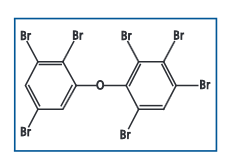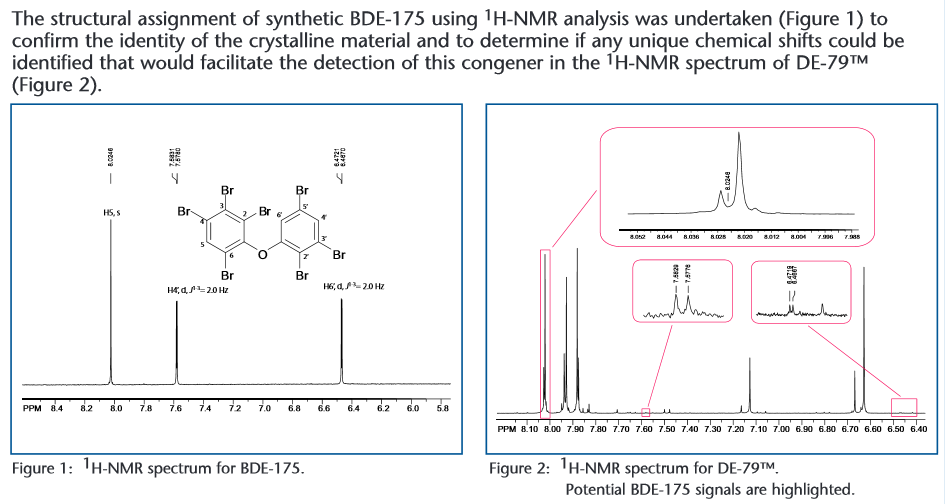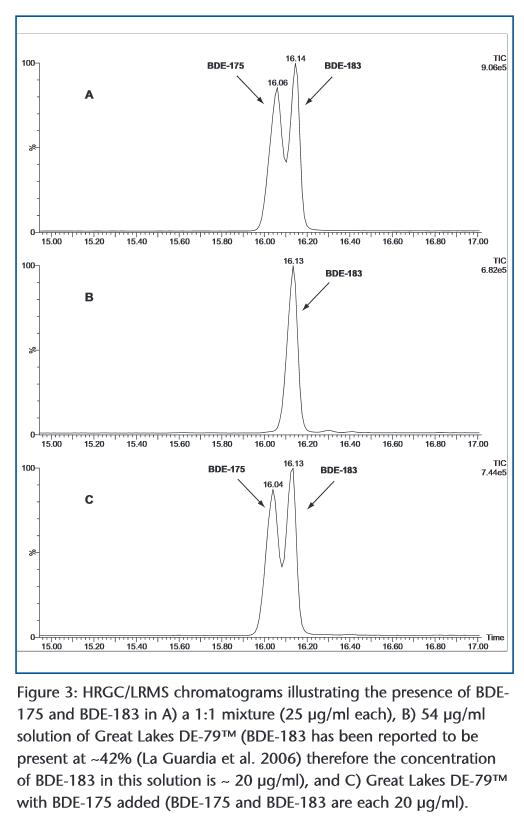The Questionable Applicability of BDE-175 as an Indicator for Commercial Octabromodiphenyl Ether
The persistent presence of PBDEs as environmental contaminants and their potential toxicity has been recognized by the United Nations Environment Programme (UNEP) through the addition of selected PBDE congeners to the Stockholm Convention.
Technical octa-BDE products are complex mixtures containing PBDEs that range in degree of bromination
from pentabrominated to nonabrominated congeners. The complex nature of an octa-BDE product
makes the analysis of some congeners by high resolution gas chromatography (HRGC) challenging since
congener co-elution can be a problem (Konstantinov et al, 2006). Recently, BDE-175 (2,2’,3,3’,4,5’,6-
heptabromodiphenyl ether) was added to the Stockholm Convention as an indicator for widely used
commercial octa-BDE mixtures such as DE-79™ and Bromkal 79-8DE™ (UNEP, 2009). It was suggested
that BDE-175, along with BDE-153, BDE-154, and BDE-183, be used as markers of commercial
octabromodiphenyl ether mixtures for enforcement purposes. However, since BDE-175 and BDE-183 co-
elute on common HRGC columns such as DB-5, its presence as a major component in technical octa-BDE
mixtures has not been demonstrated convincingly.
The work presented herein highlights the NMR characterization of BDE-175 and DE-79™ as well as the
successful separation of BDE-175 and BDE-183 using HRGC/LRMS.
Chemical Structure
The doublets observed for BDE-175 (Figure 1) with chemical shifts corresponding to 6.467 ppm and 7.578 ppm were assigned to its 2,3,5-substituted aromatic ring. The occurrence of similar doublets in the NMR spectrum of DE-79™ does not unambiguously indicate the presence of BDE-175 since these signals could belong to any BDE congener that has a 2,3,5-substitution pattern in one ring. In any event, if each of the doublets is integrated as one proton, their ratio relative to the signals known to arise mainly from BDE-183 is approximately 1:70. Therefore, although the NMR results are not conclusive regarding the amount of any BDE-175 present, if these doublets in the spectrum of the technical material are
indeed attributable to BDE-175, it would only represent a trace impurity.
The successful HRGC/LRMS separation of a 1:1 mixture of BDE-175 and BDE-183 (Figure 3A) allowed us to confirm that this congener was not present in the technical material (Great Lakes DE-79™) in appreciable amounts (Figure 3B). This finding was further verified by analyzing a mixture of BDE-175 and DE-79™ (Figure 3C). It is evident from these chromatograms that BDE-175 is not a major component in this particular commercial octabromodiphenyl ether mixture.
BDE-153, BDE-154, and BDE-183 are present in the technical octabromodiphenyl ether mixtures at significant levels and, as such, make excellent indicators for its presence in the environment. However, the need to include BDE-175 as an indicator for
commercial material is questionable since it seems likely that it is present at very low levels, if at all.
References
La Guardia MJ, Hale RC, and Harvey E. 2006. Environ. Sci. Technol 40:6247. Konstantinov A, Arsenault G, Chittim B, McAlees A, McCrindle R, Potter D, Tashiro C, and Yeo B. 2006. Organohalogen Compounds 68:105. United Nations Environment Programme. 2009.
Recommendations from the Conference of the Parties of the Stockholm Convention on Persistant Organic Pollutants,
Fourth Meeting, Geneva, Switzerland.
For over 40 years Greyhound Chromatography has been supplying high quality Chromatography consumables to laboratories around the world. Greyhound’s extensive range covers all areas of Environmental, Petrochemical, Food, Forensics, Chemical and Pharmaceutical analysis. Backed by a highly experienced technical services team, Greyhound is the preferred source amongst today’s analysts.
Greyhound Chromatography is pleased to supply Wellington Laboratories Certified Reference Standards and Materials to Research and Analysis laboratories worldwide.
CONTACT US
Tel: +44 (0) 151 649 4000
Email: marketing@greyhoundchrom.com
FOLLOW US
YOU MAY ALSO BE INTERESTED IN OUR NEWSLETTER





















